David Wingate – The Bird Man of Bermuda
“I wish I could introduce you to David Wingate,” said Gill. “He’s our local naturalist, and he’d love to answer all of these questions that you keep asking.”
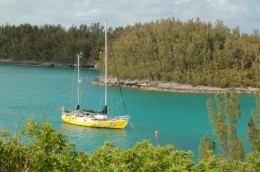
We were standing on the wooden platform which surrounds Gill and John’s house on their little islet in Bermuda, looking down towards a round black hole bored into the rock below. Inside that hole, I knew, was a plump, one week old tropic bird chick. But that was all I knew. I had a hundred questions about the tropic birds that I wanted to ask – where were the parents of the chick, for instance? And how often did they feed him? Did they come home and look after him at night? – but Gill and John did not seem to know any more than me about the bird that is supposed to be their national emblem. Perhaps their friend David could help.
“I’ll have another go at calling him,” Gill said. “Perhaps he can take you on one of his tern surveys.”
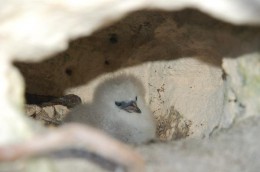
David Wingate is a professional naturalist. He has dedicated his whole life to protecting Bermuda’s birdlife and in particular to the tropic birds, the terns, and to a very rare species called the Bermuda Petrel, or cahow.
When David was a boy most people thought that the cahow was extinct and had been for 300 years. Then, when he was 17, he happened to meet up with a couple of American naturalists who believed that the seabird might still exist and might be breeding on one of the uninhabited islets. Sure enough, they found a handful of the birds – and Wingate was soon caught up in helping them in their fight for survival. Over a period of years he cleared their islet of every non-indigenous plant and animal, so that the cahows can now breed in peace.
Having spent his whole working life fighting to save the cahows David Wingate has now handed that job to a trainee. At 76 years of age he is not supposed to have the energy to chase around looking after the cahows. But Wingate is actually still twice as energetic as most people and so he has directed his energy into another project, which is a five year survey of the nesting habits of Bermuda’s common terns.
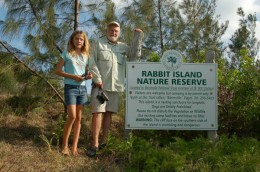
We met Wingate on the quay in Platts. He had straggly white hair and a fluffy beard, and as he led us towards his rather decrepit dory he talked to us constantly about the terns. I noticed that he walked rather stiffly and as we jumped aboard the boat he said, “I’ll need you to keep her steady, if you can. It’s these knees of mine. I had them both replaced last year, and they don’t bend like the real ones.”
Terns nest on little tiny islets which are so small that no human would ever think of visiting them – which, of course, is what they want. The first island that David Wingate took us to was smaller than Mollymawk. He explained that it was home to two chicks which were half way through their development, and also to a nest of unhatched eggs.
Common terns nest usually very close to each other, but the Bermuda ones don’t. They scrape a very shallow hollow in the ground, and usually they lay three eggs in it. The eggs look like miniature seagull’s eggs.
The terns’ success rate, according to David Wingate, is incredible. If the eggs are laid by a suitable couple then they are almost certain to survive and fledge. When I say a suitable couple, I mean a pair that consists of one male and one female. Two of the islets that we visited with Wingate had lesbian couples living on them. Two females had got together to lay six pretty but entirely useless, unfertile eggs – three each. The naturalist explained that this was not unusual nowadays. There was a great shortage of males around, and it appeared that the females would rather try to breed with another female than not breed at all, their urge was so strong.
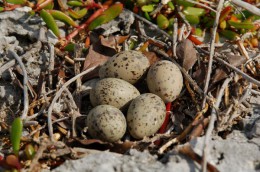
The reason there is a shortage of males is interesting. The female has had to do a lot of work to lay the eggs, and then she and the male work together to feed the hatchling. After all this effort the female is very tired, and so after her offspring have fledged she leaves. She sets off for the Pacific. But the male stays behind for a couple of weeks longer, until the newly fledged bird is strong enough to make the same long trip under his guidance.
In 1992, just after the females had left, Bermuda was hit by a hurricane which wiped out all of the newly fledged birds and also the males looking after them. The only reason the terns didn’t die out is because there were a few immature males in the Pacific, waiting to come of age and return to their breeding ground. However it will be a long time before there are enough mature males to match the number of females. In fact, at the moment there are now only 16 breeding pairs.
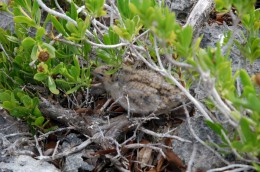
Although the islet was so tiny it took us some time, searching amongst the stones and the roots of scrub bushes, to find the two chicks. We had to walk slowly and carefully in case we accidentally trod on a chick or on those unhatched eggs. Both are very well camouflaged. All the while that we searched we were being mobbed by the adult terns, which swooped down like the seagulls guarding their nests in Isla Perdiguera.
When we found the chicks, David Wingate took out some tiny metal rings, from his pocket, and we fitted one to the starboard leg of each bird. Then he wanted to take blood samples. He held the chick with its head under his T-shirt – to stop it from panicking – and then he pricked its leg and I had to collect the blood using a tiny capillary tube. Then I dropped the drip of blood into a tiny pot of “fixative” and David labelled each one and packed it away in his collecting box.
The blood samples are being studied to see if the DNA of the Bermuda terns is the same or different from that of other common terns. Wingate thinks that his terns might be a sub-species, because their behaviour is slightly different from that of other common terns. For instance, they are more aggressive. Also, the Bermuda terns’ migration route crosses that of other common terns, but they don’t join those other birds.
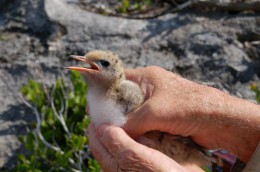
After we had finished sampling their blood we made sure that the flow had stopped, and then we put the terns down, and they scrambled back to the exact same places where we found them. You could see that the chicks always sat in the same places because there was a little white patch of guano, about a foot across, under each of them. The chosen hiding places were about a metre from the nest.
From this first islet we went on to visit two others in the same bay – and all the while the adult terns followed us. Wingate says that once, after he had been surveying terns’ nests, a tern followed him back to his house. It waited until he had passed under a row of trees, and then it dive bombed him. He went into his house, changed out of his messy, guano splattered work-clothes, and made himself a cup of coffee. Then he came outside onto the terrace – and as he walked towards his seat the tern dived down out of the sky, startling him so much that he dropped his coffee cup!
Seabirds are a lot cleverer than most people realise, with far better eyesight and recognition skills, and better memories. “Anyone else could motor their boat past these islets,” says Wingate, “and the terns would take no notice. But when they see me coming in my boat… Well, you’ve seen what happens! They know me.”
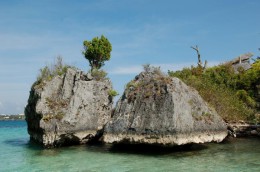
By now the wind was up and the sea was quite rough, so that when we anchored the dory beside the next islet it bucked up and down. I had trouble getting ashore. Mummy, with her camera, had even more trouble. Wingate, with his metal knees which won’t bend, would surely not be able to manage… but manage he did, hauling himself over the jagged rocks determinedly. Then we all searched for the chick which was supposed to live on this particular rock.
We couldn’t find the chick. “I can’t believe it! It must have fallen off the edge!” said the naturalist. Because the islets are undercut (by the action of a sea-squirt which attaches to the rock below the waterline) no chick which fell off its island home would ever be able to climb back up again.
“I’ve never ever had this happen before,” Wingate moaned. “In all these years…” Then a thought struck him and he looked up at the terns flying around us. “Why, there it is! Look! This is probably its first flight. See? It’s not very good at it; it wants to land again; we’d better come away so that it can return to its home.”
And so we tumbled back into the boat – first Mummy, fearing for her camera, then me, fearing for my life, and then David Wingate fearing nothing.
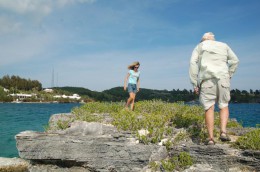
When Wingate took me on his second tern survey, of the islets south of Hamilton, I learnt the drawback to the Bermuda terns’ habit of nesting on tiny isolated places. The smaller and more isolated the rock, the better, so far as the terns are concerned, and this means that big, flat-topped ship’s mooring buoys and navigation buoys are ideal. The fact that they cannot scrape out even the tiniest of hollows does not put the birds off. They lay their eggs straight on the flat metal tops – and then, when the buoy moves, the eggs roll off into the sea.
It might seem that a few eggs each year rolling into the sea doesn’t matter much – but when you have only 16 pairs of birds it could be crucial to the survival of the species.
“It’s really quite difficult to know what to do,” Wingate told me, as he zoomed his decrepit motor boat alarmingly close past a big navigation buoy. (“No eggs on this one, I see.”)
“We can put nest boxes on the buoys,” he went on. “That would stop the eggs from rolling into the sea. But it would encourage even more birds to nest there, and we don’t want that.”
“It used to be worse,” he added. “There used to be a couple of huge buoys for the ships to moor to. They had loads of room, and they were so big that the eggs could roll around and not fall off the edge – until a ship came and tied to them. Then the whole thing would tip on its side, and you might lose a whole years’ offspring in one minute.”
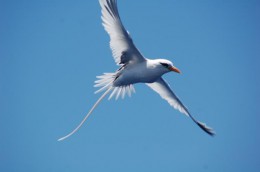
David Wingate’s other concern nowadays is tropic birds, and so at last I was able to get answers to all of my questions. These birds are migratory too, and the first ones arrive back in Bermuda on about the 1st of April. Like many seabirds, they go straight to the place where they nested last year. In their case the nesting place is a hole in the side of a cliff, and here they lay one egg. The egg is incubated for 43 days, with the parents taking it in turns to sit on it. But they don’t come and go, swapping places every few hours, like blackbirds or finches. Instead, they each sit on the egg for about ten days at a time, while their partner goes off to feed!
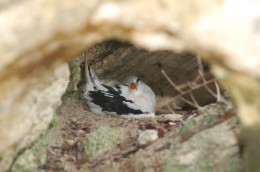
At the end of the 43 days the egg hatches and the mother and father both head out to sea. The new baby can expect two meals a day – one from each parent. The rest of the time they spend fishing, sometimes flying more than 200 miles away from the island. This we know, because we have often seen them. They are usually seen in pairs or in groups of up to ten birds which follow each other around, shrieking. They often try to land on our masts, but they never can because the masts are moving too much. Sometimes one of them crashes into the sails, but they never seem to get hurt.
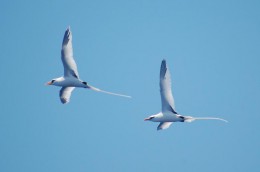
Occasionally one of the adult tropic birds comes and sits in the burrow with the chick. I never remembered to look and see whether either of them is with the chick during the night. I am sure that they are not both with him, because while we are sailing we often hear tropic birds flying around the boat at night, shrieking.
The parents carry on feeding their fluffy chick for around 65 days, and the little fellow gets very fat. Far fatter than them! In fact, Wingate told me that sometimes a chick can’t get out of its burrow, it is so fat! Then it has to diet for a while before it can come out and fly.
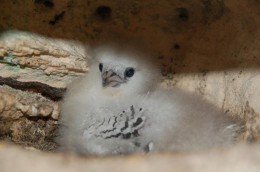
I was interested to hear of this difference between the tropic birds and my seagulls. Seagulls start to flap their wings when they are quite small. They jump in the air and flap, and eventually, when they have proper feathers, they begin to make very short flights. This seems like a sensible way to learn to fly. But tropic birds don’t have the opportunity to flap their wings, in their crowded burrows, and they don’t have the chance to do bunny hops. One day they just walk to the mouth of the burrow and they fly.
As part of his effort to promote and protect the tropic birds David Wingate installs “igloos” for them to nest in. These artificial nesting sites are about 70cm across and 30cm high and, as the name suggests, they are igloo-shaped, with a doorway on one side. They have thick walls, made from mashed paper which is covered in fibreglass and painted a murky green. This helps to keep them cool inside. Wingate encourages any Bermudians who live on the smaller islets to buy a couple of these igloos and set them up, on the edge of a low coral cliff, in their gardens. Of course, they have to be placed where a cat can’t get at them. Rats and mice are not a problem, says Wingate, because the tropic bird chick can defend itself from these dangers.
Although David Wingate is now all into protecting tropic birds there was a time when he used to shoot them. This was during the early days of his campaign to save the endangered cahows.
These small, drab seabirds are said to have been very common in Bermuda when people first visited the islands, but when they began to settle, and to introduce cats and pigs, the birds soon vanished. (Same old story.) Like the tropic birds, and like other species of petrel, cahows nest in burrows, and the cats used to climb into the burrows, and the pigs used to dig the burrows apart as they rooted through the ground.
When the cahows were rediscovered, nesting on one of the off-lying, uninhabited islands Wingate wondered why there were not more of them. Then he found that they had another enemy: the tropic bird. Tropic birds don’t attack cahows, but they were competing with them for nest sites. The cahows lay their eggs in the winter, and by the time the tropic birds would arrive in Bermuda the chicks had already hatched. The tropic birds were not pleased when they discovered that someone else had already set up camp in their own cosy burrow… Like shearwaters – and unlike tropic birds – adult petrels only come ashore and visit their nests at night, so that the poor cahow chicks had no one to present their side of the argument or to defend them. The big tropic birds would hassle the chick, pecking and poking it until it finally fell out of the door of the burrow, to its death. Wingate discovered tiny skeletons – the remains of generations of unlucky cahows – piled up outside almost every burrow on the island.
So Wingate bought a gun and started shooting tropic birds. This seems a bit mean to me, and also rather pointless: one man could not hope to kill off all of the tropic birds. And who says cahows are better than tropic birds, anyway? Tropic birds are beautiful. Everybody loves them. Cahows only ever approach the land at night, so no one ever even sees them.
But perhaps whether they are beautiful and seen is not the point either…?
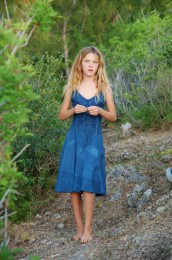
Playing God is very complicated, as Wingate would be the first to tell you. He pretty soon realised that shooting tropic birds was not the answer, and he came up with a new idea. Cahows are smaller than tropic birds, and so he put barriers across the entrances to the cahow’s chosen nesting sites – all those burrows with a decade’s worth of corpses outside the door – and this stopped the tropic birds from squeezing past.
Problem solved. Well, unfortunately, not quite. Now the tropic birds were no longer a problem, but the cahow numbers still did not recover. In fact, they declined. Wingate investigated and he found that eggs were being laid but that they were not hatching. He sent them off to be tested, and it was found that the eggs contained DDT.
DDT is a poison. It was used a lot in the 1950s and 60s to spray on crops all over the world to kill insects. It did this job extremely well, and it was a little while before people realised that it was killing everything else as well. The birds which ate the sickened insects were poisoned, but before they died they were eaten by hawks and other raptors which accumulated so much of the poison that their reproduction was affected. Their eggs were no longer fertile.
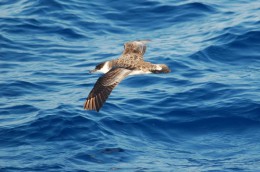
And the poison also soaked into the ground with the rain and ran into the rivers, which spewed it into the sea. Once in the sea, the DDT worked its way through the marine food chain, poisoning fish and shellfish and all life, and destroying the animals’ ability to reproduce. Those seabirds which did hatch were tenderly nurtured by their loving parents on a diet of DDT-rich fish…
It’s ironic really. The best way to destroy large numbers of insects is to have large numbers of insect-eating birds to do the job, but humans, with their stupid desire to take control of nature and their high opinion of their own intelligence, actually wiped out most of the birds! And they are still wiping them out, with other poisonous pesticides.
Also, it seems to me that putting poison onto our food is rather unintelligent, because it means that we have to eat poison. And spraying it is even stupider, because the poison gets into the air and travels around the world – and we all have to try to breathe that poisoned air!
So we see that the study of one seemingly insignificant and irrelevant seabird, which almost no one will ever see, is tied in with the fate of all of us. Wingate’s discoveries of DDT in the eggs of a bird which has no contact with insects or even with fields, or with any place which was ever sprayed with DDT, helped to get that particular poison banned.
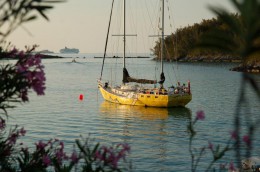
But the way things are all tied in together, and the way in which all life on this planet is so threatened, also makes me wonder about the life and work of a naturalist. I greatly admire David Wingate for the way he has devoted his whole life to protecting two dozen cahows – but I also can’t help thinking that if we tackle this problem species by species it’s going to take a long time to save the world.
I don’t think we have that much time left now. So either we need tens of thousands of David Wingates, each determinedly protecting one species with all their energy, or else we need for all of the people – all who understand the problem which we are facing – to determinedly protect all of nature, everyday, in every way that we can.

Thanks Roxanne for this. I’m glad to have read it on New Year’s day at the start of a new decade. I so agree with you and try to give similar messages in my own work – and say that we can all make a difference in the way we behave to each other (particuarly adults to kids) as well as towards our environment. Happy New Year to you and the family. XX
Well written , well done! Though my wife and I are not taking care of any seabirds at present, we do make an effort to teach our children about the web of life that binds all living things together on this planet. Thank you so much for this wonderful article.
Sincerely,
Andre D’Elena
He’s my grandpa!?